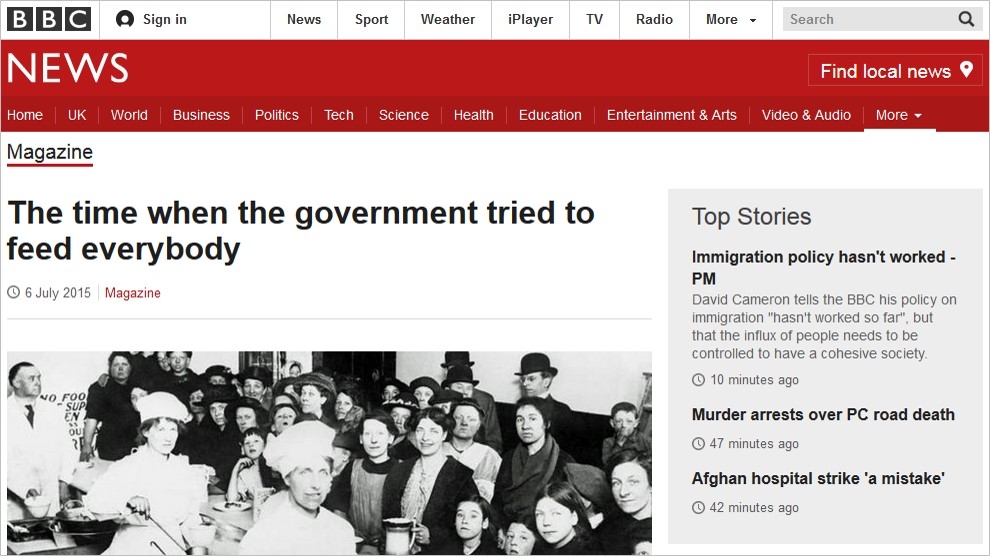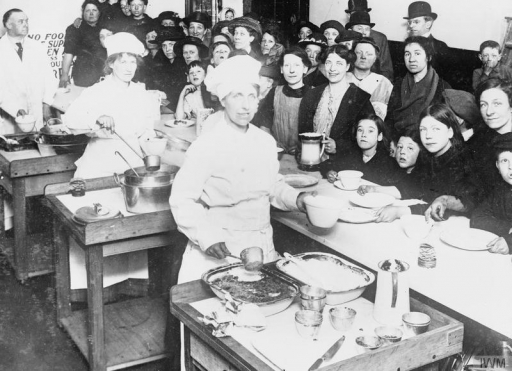Public reaction in the UK to a recent BBC News item featuring Dr Bryce Evans’ research on national kitchens has convinced the historian that the British approach to communal feeding in the First World War can have a contemporary impact. Dr Evans has written the following feature for Centenary News.
Public reaction to the research on National Kitchens in the UK during the First World War
Public canteens, or ‘national kitchens’, are an under-documented part of the Home Front experience in the First World War. Hundreds operated up and down the country between 1917 and 1919 and, thanks to funding from the Wellcome Trust, I’ve been researching and publicising them. But I stumbled into the history of communal dining in the First World War almost by accident.
I’d always found the role of food in wartime – pricing, distribution, morality – fascinating. It’s the subject of my last book (which examines the issue in Ireland during the Second World War) and last year I hosted a conference entitled ‘Food in the First World War’ which explored the wartime food issue from all angles: military, social, political, economic, cultural.
Yet communal dining was not so much a research interest of mine as something I did in my spare time. Moving back to the UK in 2011 I was shocked at the high incidence of food bank use.
Food Banks
Since 2011, the number of food banks has continued to rise steadily. The Trussell Trust network has grown to 445 food banks, and the charity’s most recent annual figures also show that around 500,000 different people are thought to have received help over the last 12-month period. And then there are the hundreds of independent food banks not affiliated to Trussell.
While admiring the voluntarist ethic of the food bank, I worried about these trends. I was concerned that ‘food poverty’ was becoming institutionalised in Britain, with some politicians keen to point to the food bank as the big society in action.
Seeing the stigma attached to food bank hand-outs, I came to doubt that the food bank was a sustainable long-term solution to poverty. Nutritionally, most food banks only have the storage facilities to hand out non-perishable items like pasta, cereal and cans rather than fresh fruit and vegetables. And socially, very few offer people the chance to sit and eat and chat together.
That’s why I helped set up a community kitchen. Unlike food banks, we aim to bring people together to eat nutritious food prepared as a meal. The simple act of breaking bread together has far-reaching consequences for mental health and social cohesion, not to mention the environmental benefit of using what supermarkets term ‘waste’ food. We don’t provide emergency food relief like food banks, are aware of our limitations and have no vested interest in maintaining the status quo when it comes to food poverty. But we do provide a cooked, hearty meal for anyone and everyone for around one pound.
So, for the first time in my career, and going against my historical training, everyday experience prompted me to investigate historical precedent. I came across Peter Atkins’ great work on ‘national restaurants’ in the Second World War. And then I came across their First World War predecessors: national kitchens.
National Kitchens
The government’s bold national kitchen programme grew out of grassroots community kitchens run by charities and trade unionists. It was to last two years, from 1917 to 1919. Predating the introduction of full rationing, national kitchens outlasted the armistice before having their Treasury funding removed in 1919.
They offered cheap food for the masses. A bowl of soup, a joint of meat and a portion of side vegetables cost 6d – just over £1 in today’s money. Puddings, scones and cakes could be bought for as little as 1d (about 18p). These self-service restaurants, run by local workers and partly funded by government grants, offered simple meals at subsidised prices.
And yet they were not charities. The Ministry of Food instructed that the kitchens “must not resemble a soup kitchen for poorest section of society”. They should feel like places “ordinary people in ordinary circumstances” could sit down together at long canteen tables for a meal which, although cheap, was not free.
Neither did they just cater to the very poor. Great efforts were made to make sure they were attractive places run along business lines and avoided the taint of charity. It encouraged middle-class professionals like clerks and office workers to come in and sit alongside working class families.
The Ministry of Food seized on their potential for efficiency. Wholesale purchasing and the collective preparation of food, they reasoned, would help cut out waste. So local authorities were urged to open up public cafeterias wherever possible. If an outlet followed Ministry of Food guidelines, the local authority received a Whitehall grant covering half the costs.
In May 1917, Queen Mary opened the first government-backed national kitchen on Westminster Bridge Road in London. By the end of 1917, national kitchens were popping up in almost every British town and city. At the height of their popularity in 1918, 363 national kitchens were doing business across the country. Wartime civil servants at the Ministry of Food eagerly discussed whether national kitchens might become a “permanent national institution”.

Screen image from the BBC news website
BBC Coverage
When the BBC covered my research in July 2015 I mischievously suggested that national kitchens were now due a revival and that communal dining, partly subsidised by local government, could provide a way out of the current food poverty crisis. As I did so, I could hear the alarm bells ringing in my ears: historians should interrogate the past dispassionately and without contemporary agendas. Moreover, contexts then and now are very, very different. I know, I know. I had broken one of the golden rules. I sat back and waited for the backlash.
But it didn’t arrive. Instead I was inundated with emails and telephone calls from people who thought that the revival of national kitchens would be a great idea.
Then there were the dozens of people wondering how they could go about opening a national kitchen and looking to me for guidance. Most heartening was the response from what one might term the young working poor: middle class young professionals working in London and other cities who loved the idea of cheap communal dining; much like the city clerks who sat down beside their working class counterparts to eat cheaply in the First World War, these young men and women wanted somewhere to eat lunch which was neither trendy nor going to cost them a small fortune.
I’m afraid my responses to these emails and telephone calls were full of caveats: the national kitchen movement of the First World War was destroyed by the opposition of the restaurant trade; in today’s age of austerity the state is rolling back spending not splashing it on cheap cafes; national kitchens one hundred years ago were viewed as politically suspect due to their communalist leanings and disappeared almost as quickly as they appeared.
And yet, and yet … in some ways, the revival of communal dining in Britain is already underway. Quietly. There are hundreds of examples of egalitarian eating underway right now: community kitchens, community cafes, pay as you feel canteens, and, slowly but increasingly, food bank cafes. The press might focus on the food bank and monopolise the Trussell Trust as an opinion former on food poverty, but an alternative approach to food poverty based on people sitting and eating together is forming and will, maybe, provide a template for the evolution of the food bank and our attitude to food poverty. And some of these ventures, like national kitchens, are being subsidised by local government: for example four regional pilot schemes arising from last year’s parliamentary inquiry ‘Feeding Britain’.
National kitchens, it seems, might not be a thing of the past after all.
Dr Bryce Evans is Senior Lecturer in History at Liverpool Hope University. His research into national kitchens was funded by the Wellcome Trust and will be published shortly as an academic journal article. He blogs about food policy and food history on his website: www.drbryceevans.wordpress.com
